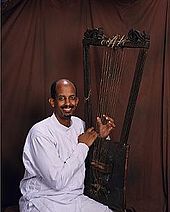Beganna
Beganna ( Amharic በገና bägäna ), also bagana, begana, begena, begenna, bägänna , is a large box lyre with eight to ten strings that is widespread in Ethiopia . In contrast to the smaller krar , the beganna is not played in restaurants ( tej bets ). It is used to accompany songs with a solemn or religious character. You place them on the floor and pluck with your fingers or a plectrum . The left hand usually plays the melody, often an octave below the singing voice due to the low pitch; the right hand usually holds the instrument by the frame.
Design and style of play
According to Ethiopian tradition, the beganna is the legendary, biblical harp of David that the mythical son of Solomon and the Queen of Sheba, Menelik I , after a visit to his father in Jerusalem with the Israelites around 1000 BC. To have brought to Ethiopia. The beganna therefore only accompanies religious music and must never be played together with other musical instruments. In fact, in the first centuries AD, the lyres probably spread from Egypt to Nubia , where the tanbura (also kisir ) and the simsimiyya are played on the Red Sea to Aksum .
The sound of the beganna can be heard especially during Christian Lent before Easter and Christmas . The components of the name be , "during", and genna , "Christmas", indicate a connection between the instrument and the Ethiopian Lent.
The design, mood and style of play should hardly have changed since ancient times. The mostly wooden body is covered with parchment made of ox skin; unlike other African lyres, there are no rattles attached to the wooden yoke ( kenber ) and to the body. Due to the size of the resonance body and the length of the gut strings, the beganna sounds deep. The ten gut strings symbolize the ten commandments and are tuned pentatonic . The side arms of the instrument bear the names of the archangels, the body symbolizes the Virgin Mary, the yoke God himself. Since the beganna is associated with the name of David, it was for centuries an instrument of the nobility and clergy. Many rulers were Beganna interpreters themselves. After the beganna became rare during the period of military rule , it has experienced a renaissance since the mid-1990s. The number of instruments and beganna players built is increasing, also because the instrument can now be played by people of all social classes.
In contrast to the smaller bowl veil krar , the beganna is only used for meditation, the singing of psalms and events from Ethiopian history. The beganna is played seated by men and women. The large instrument stands either on the thigh or on a chair. The strings are plucked with the left hand while the right hand holds the instrument. Either the vocal melody is plucked or an accompanying, background tone sequence. The songs sung at the beginning can last longer than ten minutes, depending on the memory of the performer. The gently snarling sound created by snarling bars under each string and the repetitive melody sequences create a meditative mood. In a rare and probably older technique, the beganna is struck rhythmically with a plectrum in the right hand, while the left hand mutes the strings that are not supposed to sound.
literature
- Ronald Lah, Stéphanie Weisser: Beganna . In: Laurence Libin (Ed.): The Grove Dictionary of Musical Instruments. Vol. 1, Oxford University Press, Oxford / New York 2014, pp. 292f
Web links
- Orthodox Tewahedo Begena Derdari Sosina Gebre Eyesus Getachine Begergeme. Youtube video
- Alemu Aga from Ethiopia playing the Begenna - David Harp: Aba Geragn Mote. Youtube video
Individual evidence
- ^ Ulrich Wegner: African string instruments. (New episode 41. Department of Ethnic Music V.) Museum für Völkerkunde Berlin 1984, p. 95

